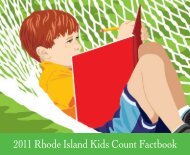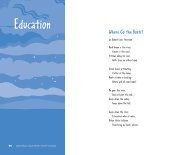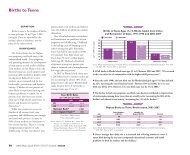2010 Rhode Island Kids Count Factbook
2010 Rhode Island Kids Count Factbook
2010 Rhode Island Kids Count Factbook
Create successful ePaper yourself
Turn your PDF publications into a flip-book with our unique Google optimized e-Paper software.
35<br />
Children in Poverty<br />
DEFINITION<br />
Children in poverty is the percentage<br />
of children under age 18 who are living<br />
in households with incomes below the<br />
poverty threshold, as defined by the<br />
U.S. Census Bureau. Poverty is<br />
determined based on income received<br />
during the year prior to the Census.<br />
SIGNIFICANCE<br />
Poverty is related to every KIDS<br />
COUNT indicator. Children in<br />
poverty, especially those who experience<br />
poverty in early childhood and for<br />
extended periods of time, are more<br />
likely to have health and behavioral<br />
problems, experience difficulty in<br />
school, become teen parents, and earn<br />
less or be unemployed as adults. 1,2<br />
Children in low-income communities<br />
are more likely to attend schools that<br />
lack resources and rigor; are less likely<br />
to be enrolled in a preschool; and have<br />
fewer opportunities to participate in<br />
extracurricular activities. 3,4,5<br />
Black and Hispanic children<br />
nationally and in <strong>Rhode</strong> <strong>Island</strong> are more<br />
likely to grow up poor than White<br />
children. Children under age six, who<br />
have single parents, whose parents have<br />
low educational levels, or whose parents<br />
work part-time or are unemployed are<br />
all at increased risk of being poor. 6,7<br />
In 2009, the federal poverty threshold<br />
was $17,285 for a family of three with<br />
two children and $21,756 for a family of<br />
four with two children. 8 The federal<br />
poverty threshold underestimates the<br />
number of families who struggle to meet<br />
basic needs. The method of calculating<br />
the poverty level has not been adjusted<br />
to address changes in family expenditure<br />
patterns since its development in the<br />
1960s, particularly the rising costs of<br />
housing, child care, medical care, and<br />
transportation. It also does not consider<br />
geographic variations in the cost of<br />
living from state to state or for urban<br />
versus rural areas. 9,10,11,12<br />
According to the 2008 <strong>Rhode</strong> <strong>Island</strong><br />
Standard of Need developed by the<br />
Poverty Institute, a single parent with<br />
two children who has an income of<br />
$30,800 a year (175% of the 2008<br />
federal poverty level) and subsidized<br />
child care and health care (RIte Care)<br />
would still be $48 short of paying for<br />
basic needs each month. A family of<br />
four with two children and an income<br />
of $37,100 a year (175% of the FPL)<br />
would have an even larger gap ($103<br />
per month). 13<br />
Children in Poverty<br />
2005 2006 2007 2008<br />
RI 19.5% 15.1% 17.5% 15.5%<br />
US 18.5% 18.3% 18.0% 18.2%<br />
National Rank*<br />
22nd<br />
New England Rank** 5th<br />
*1st is best; 50th is worst<br />
**1st is best; 6th is worst<br />
Source: U.S. Census Bureau, American Community<br />
Survey, 2005-2008. Table R1704.<br />
30<br />
25<br />
20<br />
15<br />
10<br />
40%<br />
35%<br />
30%<br />
25%<br />
20%<br />
15%<br />
10%<br />
5%<br />
0%<br />
5<br />
0<br />
Children in Poverty, by Race and Ethnicity, <strong>Rhode</strong> <strong>Island</strong>, 2006-2008<br />
16%<br />
All Races<br />
37%<br />
Native<br />
American<br />
30%<br />
Black Hispanic* Asian White Two or<br />
More Races<br />
Source: U.S. Census Bureau, American Community Survey, 2006-2008. Tables B17001, B17020A, B17020B, B17020C,<br />
B17020D, B17020G and B17020I. *Hispanic children may be included in any race category.<br />
◆ Between 2006 and 2008, 16.1% (36,970) of <strong>Rhode</strong> <strong>Island</strong>’s 228,980 children under<br />
age 18 with known poverty status lived in households with incomes below the federal<br />
poverty threshold. 14<br />
◆ In <strong>Rhode</strong> <strong>Island</strong> as well as in the United States as a whole, children who are racial and<br />
ethnic minorities are more likely to live in families with incomes below the federal<br />
poverty threshold. Between 2006 and 2008, about one in three Native American (37%),<br />
Hispanic (34%), and Black (30%) children in <strong>Rhode</strong> <strong>Island</strong> lived in poverty, compared<br />
to 16% of Asian children and 10% of White children. 15<br />
◆ While Native American, Black, and Asian children in <strong>Rhode</strong> <strong>Island</strong> are more likely to<br />
experience poverty than White children, children from these groups represent less than<br />
20% of all children living in poverty in <strong>Rhode</strong> <strong>Island</strong>. Between 2006 and 2008, of all<br />
children living in poverty in <strong>Rhode</strong> <strong>Island</strong>, almost half (48%) were White, 15% were<br />
Black, 3% were Asian, 1% were Native American, 27% were “some other race” and 6%<br />
were two or more races.<br />
◆ Between 2006 and 2008, 43% of <strong>Rhode</strong> <strong>Island</strong>’s poor children were Hispanic.<br />
Hispanic children may be included in any race category. The Census Bureau asks about<br />
race separately from ethnicity, and the majority of families who identify as “some other<br />
race” also identify as Hispanic. 16<br />
34%<br />
16%<br />
10%<br />
21%<br />
36 <strong>2010</strong> <strong>Rhode</strong> <strong>Island</strong> KIDS COUNT <strong>Factbook</strong> / Economic Well-Being






